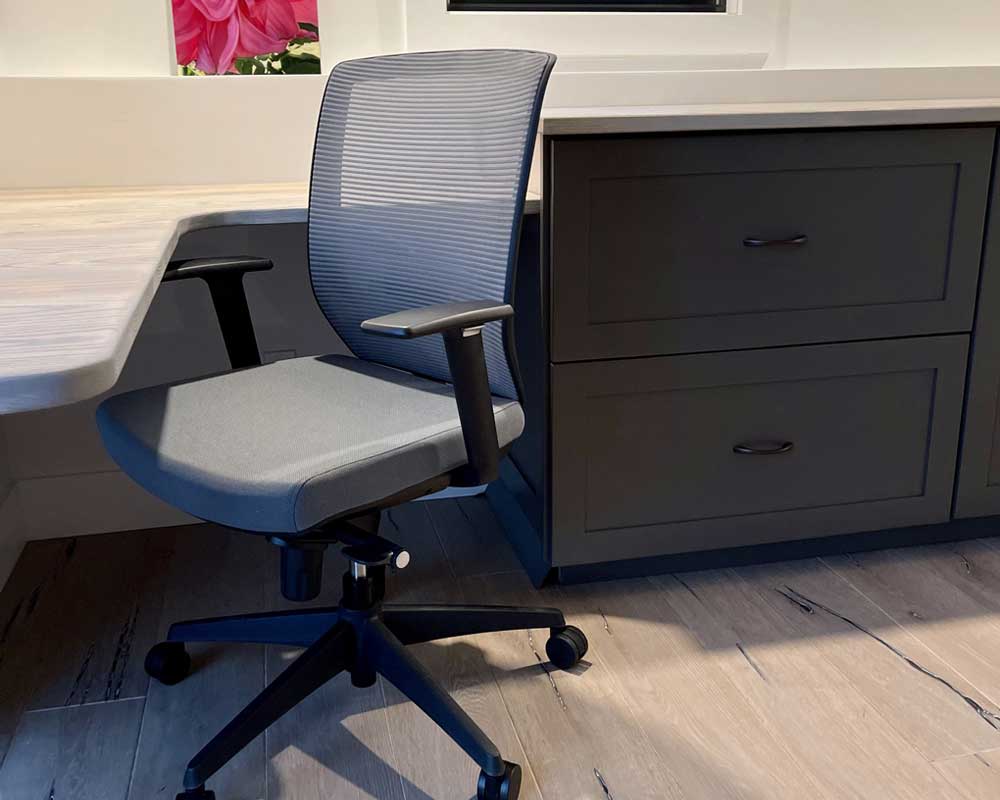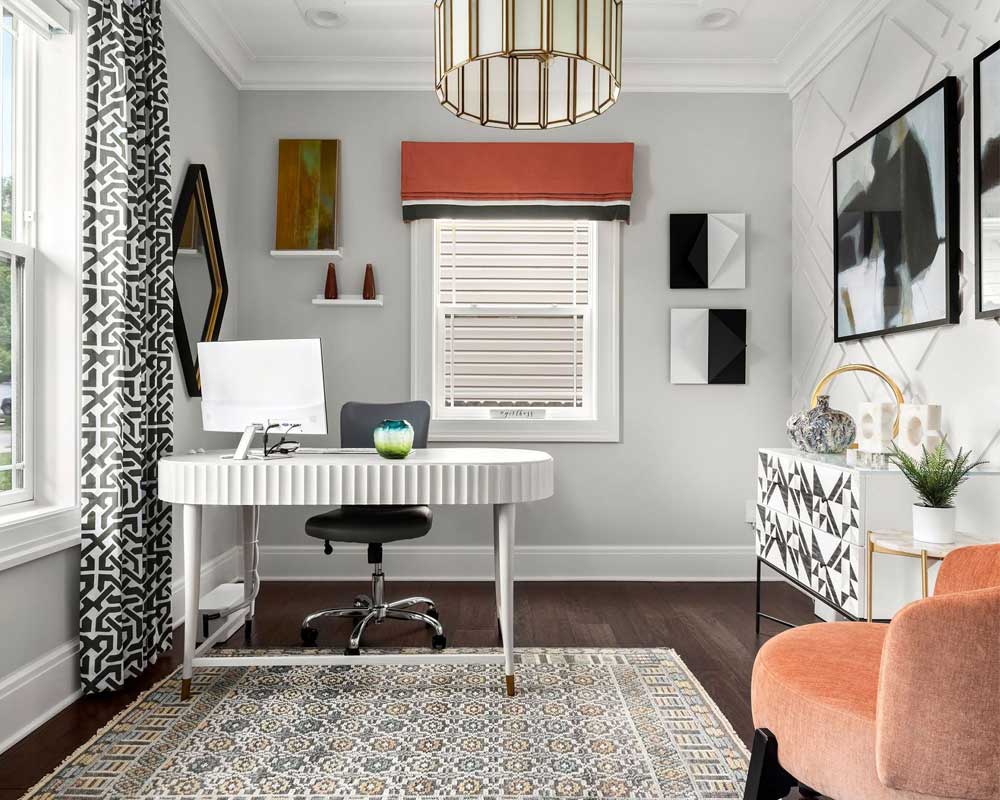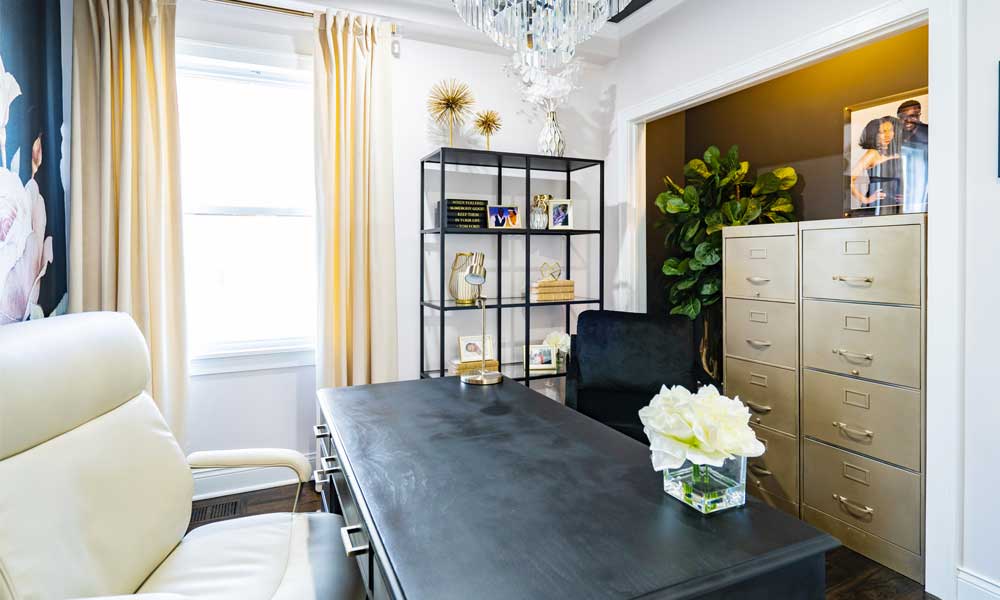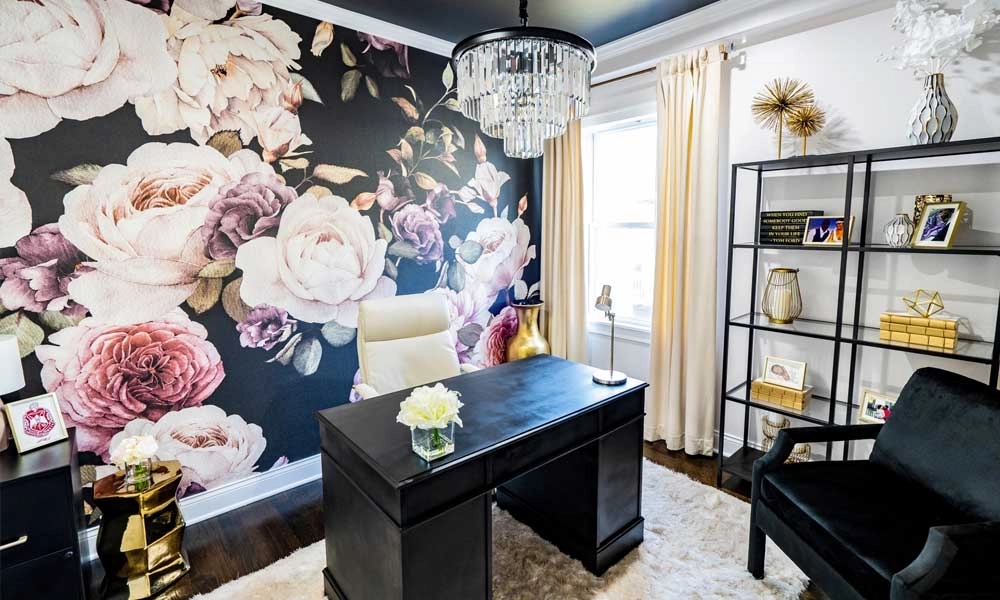Whether you’re thriving or surviving at work, having a home office that inspires will make your day-to-day experience a little easier… or at least more efficient. After all, most people spend more time at their desks than in their beds.
We chatted with interior design experts for input on how to design a home office that works for your needs, schedule, and space.
Tip: don’t skimp when it comes to an office chair.
5 Things You Should Consider When Buying Home Office Furniture

1. Your Body and Comfort
The most important thing to keep in mind when shopping for any piece of furniture is comfort. Office furniture is no different. Thankfully, there are plenty of options that prioritize comfort and ergometry.
“Office furniture has evolved to accommodate our bodies and patterns of work that were unthinkable 10 years ago,” says Jarret Yoshida. “Stand up desks, treadmills, monitor height adjustments are all available now.”
However, before you buy, Yoshida suggests assessing your body and what has caused comfort or discomfort in the past. “Then, and only then, consider your budget and aesthetics… remember that this is not the time to skimp. Spending a few hundred more on something you will use for nearly forty hours a week is an investment in your health.”
2. How You’ll Use the Office
Additionally, consider how you’ll use your home office. Do you take a lot of video calls? Will you be working from another location part time? All of these factors contribute to what you’ll need to effectively design your office.
“The first piece of information I need from a client is understanding how the office will be used,” says April Gandy. “Knowing how the space will be used helps me determine what we need in the space. Ultimately, I can choose appropriately sized furniture once I know everything I need to fit in the space.”
Renee Thompson agrees, adding that considering whether “it will be a shared space with others in your home, or for other purposes” is key to making the space function properly.
3. The Space Itself
And of course, an important factor in considering home office furniture is the space itself. The space will inform the type and amount of furniture you need to make the space both beautiful and functional.
“Considerations for lighting and space planning will heavily depend on the type of room you use, and its privacy from the rest of the house,” says Mindy O’Connor. “Home offices can be far more well considered than those outside of the house for creating a really enjoyable space to spend time with some planning.”

4. Style
Once you’re ready to start considering specific pieces, style is an important fact to keep in mind. “Choosing office furniture that is consistent in style, color, and design will make your home office more cohesive,” says Belle Fortte. “Your space should reflect your personality and have your values, so a stylish workspace will not only impress your family, friends, and visitors, but will also put you in a good mood to start your workday.”
Dave Adams adds, “regardless of the size of your space, it’s important to incorporate furniture that not only is functional, but complements your home aesthetic and allows you to bring in a bit of personal style.”
5. Budget
Finally, consider your budget. To Belle Fortte, when your budget is limited, less is more.
“Budget will be a decisive factor when purchasing furniture,” says Belle Fortte. “While it may seem easy to choose less expensive furniture to save money, it will only cause you further stress and expense down the line. If your budget is low, I recommend the number of pieces you purchase.”
How to Choose a Desk
What to Consider When Buying a Desk

Functionality
When shopping for the perfect desk, functionality is number one. April Gandy says, “once I know what the client needs to establish a functional work space, I can turn my attention to aesthetics… some clients require multiple monitors, so a larger desk is needed, while others just need the basics.”
Many contemporary “smart desks” come with built-in outlets or USB ports, that make plugging in your laptop charger a breeze.
Surface Space and Storage
Consider how much desktop surface and storage furniture you need before choosing a desk. Do you need to have a space to write on or keep paper documents, or simply look at a screen? Mindy O’Connor says that “a beautifully minimal desktop surface won’t look good if it simply ends up piled with documents and supplies.”
Renee Thompson advises “making sure you can tuck things away in drawers and storage cabinets so you don’t get overwhelmed with piles of things all over… after all, if your desk functions well, you function well.”
How You Like to Work
How you like to work is just as important as what you need to work. Belle Fortte recommends a customizable desk, because they “allow you the freedom to create a work-from-home desk setup that is very personalized, inspiring, and practical at the same time.” According to Fortte, this makes working from home easier and more enjoyable.
Fortte also recommends considering ergonomics. “A desk setup that is not ergonomically correct can result in health problems,” she says. “Do not conform your body to your workstation; rather, design your workstation to suit your body.”
Types of Home Office Desks

- Traditional desk: A traditional desk is built to accommodate a desk chair of a normal height, and is usually rectangular. It is not uncommon for traditional desks to come with a hutch.
- Standing desk: Built to accommodate those who prefer to stand while working, standing desks are elevated, and usually adjustable for different heights.
- Corner desk: Great for those with limited space, these L-shaped desks are built to fit the corner of a room. Just like traditional desks, corner desks are available with a variety of storage options.
- Credenza desk: A credenza desk is what you might think of when an executive desk comes to mind. This style of desk is usually rectangular, made from wood, and features drawers underneath the workspace and on both sides of the tabletop.
- Folding desk: Made to accommodate small spaces, folding desks are usually attached to the wall with a hinge and fold out for use. The small size of folding desks make them great for use as a computer desk rather than a writing desk.
- Ladder desk: Ladder desks lean against the wall, and provide overhead storage that creates the appearance of well, a ladder. These desks have a small footprint, but lots of space to store supplies.
How to Choose a Chair for your Home Office

What to Consider When Buying a Chair
Comfort, Ergonomics, and Adjustability
When you’ll likely be sitting at the same chair for forty hours a week, comfort is key — you don’t want to be sitting on a dining chair all day. Belle Fortte recommends choosing an ergonomic chair outfitted with all of the advanced and comfortable features, such as lumbar support, a backrest, armrest, padded sheets, and castor wheels.
Dave Adams says that the “ideal chair would be ergonomically engineered, fully adjustable, and crafted with premium materials to create a comfortable and versatile seating experience.” He also recommends finding furniture that’s breathable to allow for airflow.
Sitting Position
If you aren’t comfortable, you won’t be productive. When choosing the right chair for his clients, Dave Adams makes sure to find a chair that allows you to sit at a 90-degree angle, with your feet flat on the floor, as this is the ideal sitting position.
Additionally, Adams recommends making sure that your chair allows you to sit an arm’s length away from your screen, key to reducing eye fatigue.
Types of Home Office Chairs
- Task chairs: Task chairs are what you might think of when office chairs come to mind. These chairs often swivel, have a low back to promote good posture, and are usually made from breathable upholstery for all-day comfort.
- Ergonomic chairs: A step up from the task chair, ergonomic chairs are specially designed to improve back pain. These chairs usually have adjustable seat height, seat depth, and lumbar support.
- Drafting chairs: Drafting chairs are designed for those who sit at a drafting table. This means that they’re specifically built for raised desks.
- Accent/reception chairs: Accent or reception chairs are what you’d encounter in the lobby of an office building: chairs not meant for all-day ergonomic comfort, but to provide a space for guests to wait for (hopefully) a short period of time.
- Executive chairs: Known as a “boss chair,” executive chairs are designed to make a statement. These chairs have a high back, armrests, and are built to exude importance.
While all of the above chairs have their place, if you’re looking for all-day comfort from a chair that promotes good posture, we’d recommend considering an ergonomic chair. The ability to adjust the chair’s positioning to your body will keep you at your desk for as long as you need to complete your next project.
How to Accessorize your Home Office
Think About Your ‘Zoom’ Wall

Jarret Yoshida says that Zoom and video conferencing have altered the way his team decorates their clients’ homes. “My favorite hobby is creating an oversized gallery wall of travel photos blown up to fit 24x36 frames with custom matte for a Zoom wall,” Yoshida says. “It helps you enjoy your memories every day as art and has provided a talking and connection point for colleagues who may recognize your trip to the local beach or favorite mountain hike.”
April Gandy adds that “A lot of clients want well decorated accent walls that create a stunning backdrop for video calls.” When creating accent walls, Gandy loves to include sentimental items and accolades, such as plaques, degrees and shadow boxes.
Your Personal Style
According to Becc Burgmann, “Accessorizing an office space is important, as it can be the difference between being inspired in a space or dragging your heels! The office is a space that you want to be in– if you don’t want to be there, the productivity levels start to deteriorate.”
Burgmann suggests accessorizing a space by adding a rug, floating shelves, and a plant. “Greenery is said to improve productivity, artwork or prints inspire you, a funky desk lamp or an occasional chair and side table if need be to create a small breakout space.
Mindy O’Connor adds “if there is extra seating, add color with pillows… for bookcases, look for book ends and objects that inspire you, and try to avoid clutter.”
Storage and Filing
While we typically think of filing cabinets as bland, functional, pieces, Dave Adams says that “file and storage solutions come in all shapes and sizes, from mobile and lateral file cabinets to multi-functional printer stands and office credenzas.” Adams suggests that if you have the space, or require additional storage, checking out office collections that coordinate beautifully for a consistent design aesthetic.
For those that like open storage, bookshelves come in a variety of unique configurations and double as a way to display personal items.
The Best Places to Shop for Home Office Furniture
- Grandin Road: furniture combines function, innovation, and style to create environmentally friendly pieces that bring quality design and user-friendly features to all.
- Birch Lane: Birch Lane places an emphasis on modern pieces with a focus on craftsmanship.
- Herman Miller: Paola Zamudio recommends Herman Miller for pieces that inspire. The company only creates furniture for the office, and is known for their “problem-solving” designs that maximize comfort and productivity.
- HAY: Recommended by Paola Zamudio, HAY creates minimalist pieces inspired by Danish sensibilities.
- Joybird: For modern office collections constructed from eco-friendly materials. The company creates modern office pieces, and offers free design services.
- Wayfair: Wayfair good for its variety of modern furniture and home decor. Wayfair is known for their furniture sets that create a continuous look throughout the space.
- Plank+Beam: compiles high quality furniture at a reasonable price. The company offers wood furniture for those with a specific vision in mind.
- Blu Dot: From pieces that are linear to uniquely shaped, Blu Dot offers a variety of modern office furniture that will suit the needs of any space. The company was suggested by Jarret Yoshida.
- Ballard Design: Ballard Design provides a unique curation of pieces from all periods.
- CB2: CB2 creates furniture for the modern home. Shop eye-catching office chairs, desks, and accessories with this brand.
- AllModern: AllModern believes that good, practical design should be the standard, not a luxury. The brand couples modern style with modern convenience to create pieces that showcase thoughtful design and high-quality construction.
- Burrow: Here you can find all the necessary furniture for setting up a home office.
- Branch: Founded in 2018, Branch’s mission is to make it as easy as possible to shop for aesthetically pleasing, modern office furniture.














